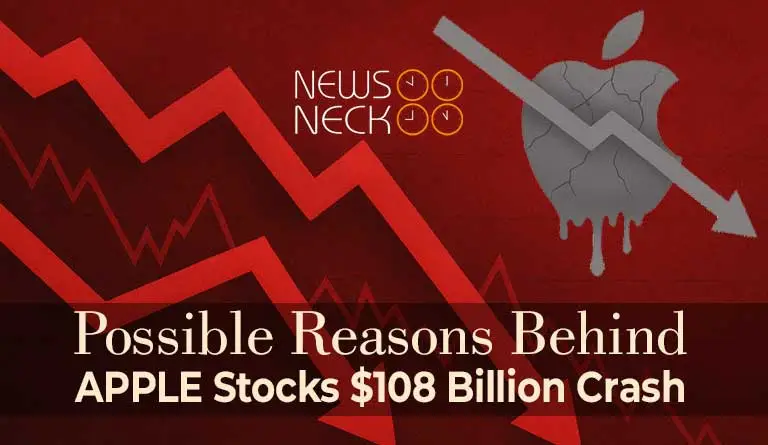Apple’s $108 Billion Crash after iPhone 17 reveal
The Big Picture: Apple’s recent $108 billion single-day market loss—triggered by a disappointing iPhone 17 launch and a deepening China crisis—has sent shockwaves through global markets. But beneath the surface, evidence suggests this may be a calculated strategic reset, echoing Microsoft’s legendary antitrust-era playbook to pivot toward AI and software dominance.
The China Collapse: More Than a Slowdown
Apple’s China sales dropped 9% year-over-year following the September 9, 2025, release of the iPhone 17 and iPhone Air . This wasn’t an isolated dip. Earlier, in June 2025, foreign sales had already plummeted by 31%, signaling a structural decline in Apple’s international dominance .
- Historic Context: China once contributed over $74 billion in annual revenue (2022) but fell to $66.9 billion in 2024 . The closure of Apple’s first-ever store in Dalian symbolizes a retrenchment that feels both symbolic and strategic.
- Local Competition: Huawei’s resurgence and China’s exploration of an antitrust probe into Apple’s App Store policies have intensified pressure . CEO Tim Cook had already acknowledged China’s revenue dip in mid-2025, attributing it partly to “lower inventory” but hinting at deeper challenges .
📉 By the Numbers: Apple’s rank as the world’s most valuable company slipped from 1st to 5th post-iPhone 17 release. Its revenue share in Greater China fell to 16% of total sales in Q1 2025 .
The $108 Billion Single-Day Crash
On September 10, 2025, Apple’s stock value evaporated $108 billion in hours—its largest single-day drop in years. The immediate trigger? Tepid response to the iPhone 17 and iPhone Air, devices criticized for incremental hardware upgrades amid industry-shifting AI advancements .
- Innovation Stagnation: The iPhone 17’s focus on form factor (e.g., “the thinnest iPhone ever”) rather than groundbreaking AI features highlighted Apple’s lag in the AI arms race . Meanwhile, rivals like Google and OpenAI aggressively marketed generative AI integrations.
- Investor Patience Frays: Apple’s shares had already fallen 15% in 2025 amid concerns over its AI roadmap . The September crash exacerbated fears that Apple’s hardware-centric model was becoming obsolete.
The Strategic Reset Theory: A Microsoft Playbook?
Beneath the panic, a counter-narrative emerges: Apple is orchestrating a controlled demolition to reposition itself for long-term dominance. Here’s how:
1. The Antitrust Avoidance Strategy
The U.S. Department of Justice’s antitrust lawsuit against Apple in March 2024—echoing the United States v. Microsoft case—raised existential risks . By allowing its market valuation to dip, Apple may be preemptively reducing its perceived monopoly power, much as Microsoft did in the early 2000s to avoid a breakup.
- Historical Precedent: Microsoft’s consent decree in 2002 forced it to open APIs and avoid retaliatory practices, ultimately fueling innovation like iTunes for Windows . Apple’s current retreat could mirror this “strategic humility” to placate regulators.
- Global Pressures: The EU’s $2 billion fine and China’s antitrust probes create a multi-front regulatory war . A smaller Apple is a less targetable Apple.
2. The AI and Software Pivot
Apple’s non-iPhone revenue—Services, Wearables, App Store, and Apple Pay—now represents 45% of total revenue, up from 24% in 2024 . This segment is growing rapidly while hardware sales stagnate.
- Apple Intelligence Quiet Rise: Despite Siri’s setbacks, Apple has aggressively integrated on-device AI into its ecosystem . Features like Live Translation, Image Playground, and Workout Buddy leverage proprietary models that prioritize privacy and offline functionality.
- Developer Access: In June 2025, Apple opened its on-device AI models to developers, enabling third-party apps to harness its LLMs without cloud costs . This move could catalyze a developer ecosystem akin to Apple’s App Store revolution in 2008.
3. The Acquisition Gambit
A depressed stock price makes acquisitions cheaper. Apple’s $158 billion cash reserve could now buy significantly more AI talent and technology. Potential targets include:
- AI Specialists: Firms specializing in multimodal AI, voice synthesis, or edge computing.
- Content and Gaming Studios: To bolster Apple TV+ and Arcade amid services growth.
- Health-Tech Platforms: Integrating AI-driven diagnostics into Apple Watch.
4. The China Exit Narrative
Closing stores in China (e.g., Dalian) and diversifying supply chains to India and Vietnam suggest Apple is preparing for a prolonged Sino-American tech cold war. By magnifying the “China collapse” narrative, Apple could be justifying a strategic pivot to investors.
The Road Ahead: AI as the New iPhone
Apple’ future hinges on replicating its iPhone ecosystem playbook with AI. Key moves to watch:
- Siri’s Reboot: A revamped, AI-native Siri is slated for spring 2026 . Its success could redefine Apple’s AI credibility.
- Services Monetization: With 1.1 billion paid subscriptions , Apple’s ability to bundle AI features into services could create a new revenue stream.
- Hardware-AI Fusion: Future devices will likely be optimized for on-device AI, leveraging Apple’s custom silicon (e.g., M4 chips) .
💡 Bottom Line: Apple’s “crash” may be a masterclass in strategic pivoting. By sacrificing short-term valuation, it could be clearing the path for an AI-dominated future—much like Microsoft’s antitrust-era reset paved the way for its cloud renaissance.
FAQs: Apple’s $108 Billion Crash
Q1: Why did Apple’s stock drop $108 billion in a day?
A: The drop was triggered by poor iPhone 17 sales and a 9% year-over-year decline in China revenue . Broader concerns about Apple’s AI strategy and regulatory pressures exacerbated the sell-off.
Q2: Is Apple losing its innovation edge?
A: Hardware innovation has slowed, but Apple is investing heavily in AI software and services . Its on-device AI tools and developer ecosystem could be the foundation of its next growth phase.
Q3: How is Apple addressing antitrust risks?
A: By allowing its market dominance to wane slightly, Apple may be reducing regulatory target on its back. This mirrors Microsoft’s approach in the early 2000s .
Q4: What is Apple’s plan for AI?
A: Apple is integrating AI across its devices (e.g., Live Translation, Image Playground) and opening its models to developers . A revamped Siri is expected in 2026 .
Q5: Could Apple acquire AI startups?
A: Yes. Its cash reserves ($158 billion) and depressed stock price make acquisitions a likely strategy to accelerate AI capabilities .
📊 Apple’s Revenue Shift: Hardware vs. Services
| Year | iPhone Revenue Share | Services Revenue Share |
|---|---|---|
| 2021 | 52% | 24% |
| 2024 | 51% | 24% |
| 2025 | 56% | 21% |
| *Source: Business of Apps, SQ Magazine * |
📉 Apple’s China Sales (2015-2024)
| Year | Revenue ($B) | Sales (M Units) |
|---|---|---|
| 2015 | $58.7 | 71.2 |
| 2020 | $40.3 | 34.9 |
| 2024 | $66.9 | 38.5 |
| *Source: Business of Apps * |
Final Thought: Apple’s crash feels less like a failure and more like a chess move. In the high-stakes game of tech dominance, sometimes you must sacrifice a queen to checkmate the king.
Author: Muhammad Junaid Arif
Date: 15 sept, 2025
For More Business Articles, Visit Newsneck













